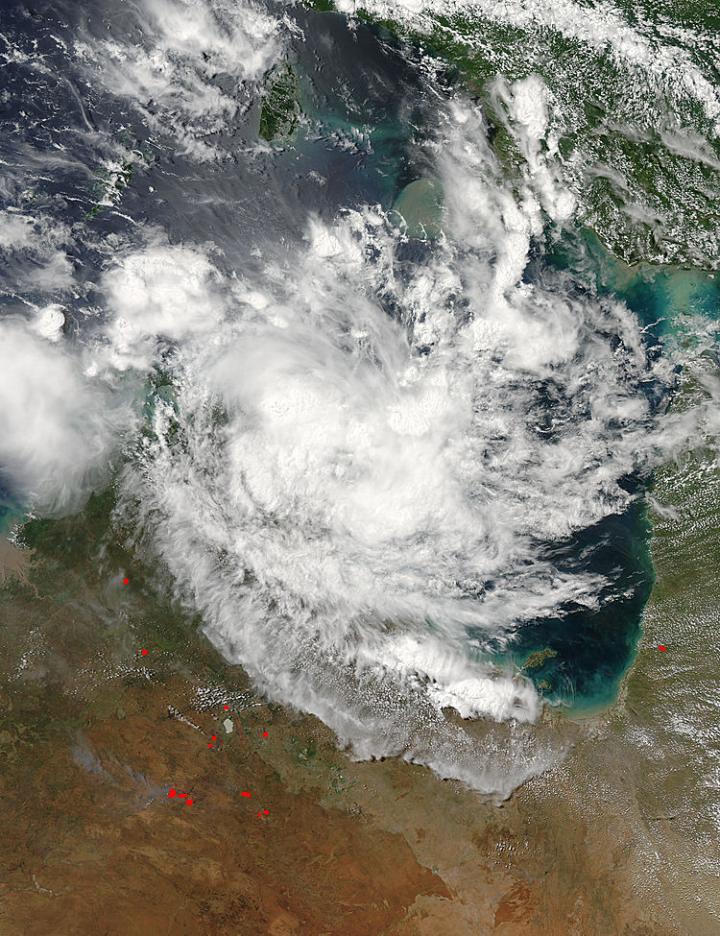NASA sees Tropical Cyclone Nathan over Australia's Top End

On March 23 at 04:35 UTC, NASA's Aqua satellite captured this image of Tropical Cyclone Nathan over the Top End of the Northern Territory, Australia. Image Credit: NASA Goddard MODIS Rapid Response Team
The Moderate Resolution Imaging Spectroradiometer or MODIS instrument flies aboard two NASA satellites: Terra and Aqua. MODIS provided images from each of those satellites over the course of three days that showed Nathan's western movement and second landfall in the Northern Territory of Australia.
On Saturday, March 21 at 04:50 UTC (12:50 a.m. EDT) MODIS aboard NASA's Aqua satellite captured Tropical Cyclone Nathan moving west through the Gulf of Carpentaria. On March 22 at 01:05 UTC (March 21 at 9:05 p.m. EDT) the MODIS instrument aboard NASA's Terra satellite saw Tropical Cyclone Nathan making landfall near Arnheim Land, in the Northern Territory of Australia.
On March 23 at 04:35 UTC (12:35 a.m. EDT), the MODIS instrument aboard NASA's Aqua satellite captured a visible mage of Tropical Cyclone Nathan over the Top End of the Northern Territory, Australia. The Top End of northern Australia is the northernmost section of the Northern Territory.
At 09:00 UTC (5 a.m. EDT), Nathan's maximum sustained winds were near 65 knots (75 mph/120.4 kph), making it a category one hurricane. Nathan's center was located near 11.4 south and 134.1 east, about 210 nautical miles (241 miles/389 km) east-northeast of Darwin, Australia. Nathan was moving west at 6 knots (7 mph/11 kph).
On March 23, the Australian Bureau of Meteorology has posted Warnings and watches for the Northern Territory. The Tropical Cyclone Warning is in effect from Milingimbi to Cape Don and Point Stuart, including Croker Island, Goulburn Island, Gunbalanya, Jabiru and Maningrida. A Tropical Cyclone Watch is in effect from Cape Hotham to Point Stuart and Cape Don to Milikapiti and eastern Melville Island. For updated conditions, watches and warnings, visit: http://www.
The Joint Typhoon Warning Center using animated enhanced infrared satellite imagery, noted that Nathan had maintained overall convective signature as it drifted just offshore of the Northern Territory.
Nathan is tracking along the northern edge of a deep-layered subtropical ridge (elongated area of high pressure) to the south, over central Australia. Later on March 23, the ridge will weaken as a mid-latitude trough (elongated area) of low pressure from the southwest approaches, causing Nathan to move southwestward toward Darwin before returning on a westward track.
The Joint Typhoon Warning Center (JTWC) expects Nathan to continue tracking to the west over the next several days. JTWC's forecast track takes the center of Nathan just south of Darwin on March 25 around 0600 UTC (2 a.m. EDT) on its way into the Southern Indian Ocean.
Media Contact
All latest news from the category: Earth Sciences
Earth Sciences (also referred to as Geosciences), which deals with basic issues surrounding our planet, plays a vital role in the area of energy and raw materials supply.
Earth Sciences comprises subjects such as geology, geography, geological informatics, paleontology, mineralogy, petrography, crystallography, geophysics, geodesy, glaciology, cartography, photogrammetry, meteorology and seismology, early-warning systems, earthquake research and polar research.
Newest articles

Innovative vortex beam technology
…unleashes ultra-secure, high-capacity data transmission. Scientists have developed a breakthrough optical technology that could dramatically enhance the capacity and security of data transmission (Fig. 1). By utilizing a new type…

Tiny dancers: Scientists synchronise bacterial motion
Researchers at TU Delft have discovered that E. coli bacteria can synchronise their movements, creating order in seemingly random biological systems. By trapping individual bacteria in micro-engineered circular cavities and…

Primary investigation on ram-rotor detonation engine
Detonation is a supersonic combustion wave, characterized by a shock wave driven by the energy release from closely coupled chemical reactions. It is a typical form of pressure gain combustion,…



